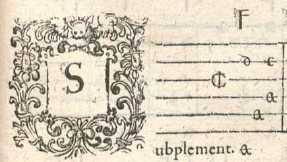Tanz—published by Georg Fuhrmann
![]() Tanz is a lute piece first published in
1615 by Georg Leopold Fuhrmann in his lute tablature compilation
Testudo Gallo–Germanica. Although commonly
called Tanz[1] and attributed to Georg Fuhrmann,
the work was published with no title and no attribution.
Fuhrmann made an effort to attribute the composer of a work when
known. Testudo Gallo–Germanica even contains a list of nomina
authorum (author's names) in the book's front
matter. When the author of a work was unknown, Fuhrmann would
often write incerti Authoris (author
unknown).
Tanz is a lute piece first published in
1615 by Georg Leopold Fuhrmann in his lute tablature compilation
Testudo Gallo–Germanica. Although commonly
called Tanz[1] and attributed to Georg Fuhrmann,
the work was published with no title and no attribution.
Fuhrmann made an effort to attribute the composer of a work when
known. Testudo Gallo–Germanica even contains a list of nomina
authorum (author's names) in the book's front
matter. When the author of a work was unknown, Fuhrmann would
often write incerti Authoris (author
unknown).
 |
Tanz is really an untitled and unattributed subplementum folii. Note the time signature is for alla breve and not 3/4.
Tanz is labeled as a subplement., short for subplementum folii (literally, page filler). It occurs immediately after Pavana Lachrimae by Valentin Strobel (attributed as V.S. and listed as Valentinus Strobelius in the Latin list of authors). Testudo Gallo–Germanica is filled with short works squeezed inside the leftover space separating larger works. Unlike the larger works, most of these subplementa are unattributed. Therefore, it is unclear if the author is the same as that of the immediately preceding work, if the author is unknown, or if Georg Fuhrmann inserted his own composition and modestly omitted his name. The prevailing assumption appears to have been that Georg Fuhrmann authored the work, although I do not know what additional evidence has been used to reach that conclusion. Also, I do not know why such a short piece is considered a dance as opposed to, say, a toy. These are possibly arbitrary—or at least subjective—determinations made by a transcriber at some point in the past and repeated by others not working from a primary source.
The source I used for my transcription was the original lute tablature from page 61 of the copy of Testudo Gallo–Germanica from Bayerische Staatsbibliothek, the Bavarian State Library. As with all music for the Renaissance lute transcribed for the guitar, if you want to play it at the same pitch as the lute, you must place a capo at the third fret. Most, if not all, transcriptions you will find show a time signature of 3/4. That is decidedly incorrect. Transcribers who choose 3/4 misunderstand the use of bar lines in old lute tablature, which does not always correspond to metrical division. Figure 1 clearly shows Fuhrmann published the piece with the time signature for alla breve or 2/2.[2] Given that the tablature is composed of quarter note triplets,[3] I've notated the equivalent 6/4, remaining true to the original intention as well as the natural tapping of your foot. Also, as is often required when transcribing lute tablature for the guitar, I have adjusted note durations to more closely reflect their actual values.
Tanz uses a dropped-D tuning and features an ostinato (a repeating musical figure) using the open bass strings. The same ostinato can be found in other works of the period (cf. Italiana (No. 59)). The only significant change I've made is to finger the melody in second position without open strings. The original lute tablature uses the high first and second open strings as part of the melody, but I felt the melody is more clear on the guitar when using open strings only for the bass ostinato. You may play the first and second open strings, if you prefer, instead of fingering the fifth and fourth frets of the second and third strings. In the list of arrangements, I rated the difficulty as medium instead of easy because coordinating the right hand thumb's playing of the ostinato with the other fingers playing the melody presents some difficulty for novice players (and even more experienced ones). Otherwise, as far as the left hand is concerned, it is an easy piece.
| Sheet Music |
|---|
| Tanz.pdf |
[1] Tanz means dance in German.
[2] For an explanation of what the half or broken circle and the half or broken circle with a vertical line mean and their misinterpretation as “common time” and “cut time”, see Music Notation, Second Edition Gardner Read, 1979, Chapter 10, pp. 156-157.
[3] Don't be fooled by the double-flags that look like F's. That's contemporaneous German notation for a quarter note.
